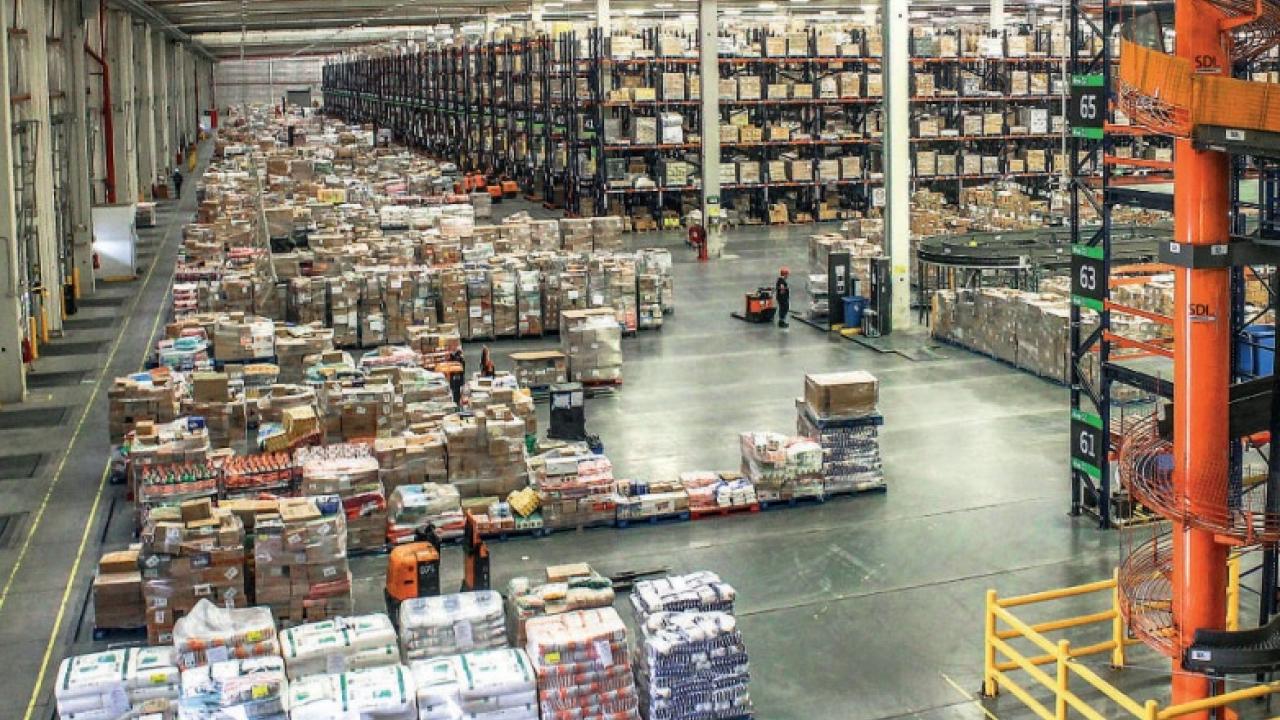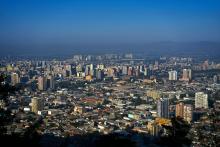
Surging e-commerce, supply chain challenges, and the need for cost reductions have deepened the commitment of large and small retailers to self-use distribution centers. A trend that is nowadays replicated by players outside the commerce industry, whose million-dollar developments appear to remain on the rise.
Following nearly fourteen months of construction, last Mach Chile's retail conglomerate Falabella inaugurated in the municipality of Cota (near Bogotá) what they define as their most advanced logistics center. The huge warehouse, worth US$ 147 million, occupies an area of 93,000 square meters, is equipped with the latest in technology for distribution and inventory management to support both e-commerce operations and supply physical stores.
Falabella has this type of warehouse in other Latin American cities, including the so-called automatic center in Villa Salvador, inaugurated in October 2022, and another bigger than 26,000 square meters in the Chilean capital, inaugurated in September last year.
Falabella is not alone. Both retail giants and smaller companies are investing heavily in logistics infrastructure to improve their delivery and save costs in Latin America, ranging from Mercado Libre and its two mega logistics distribution centers in Rio de Janeiro and Recife, plus another one in Chile, to the new Amazon distribution center in CDMX, with more than 30 thousand square meters.
“Investments in logistics centers are well diversified in terms of actors. In Chile, you can see activity in this area including retailers, such as Falabella, international operators, such as Amazon, AliExpress or shipping companies, local logistics operators, and also new entrants, such as real estate operators that are attracted by high demand and low vacancy for this type of assets,” Luis Llanos, professor of Industrial Engineering at the University of Chile, tells AméricaEconomía.
Partly due to the e-commerce boom but also due to the growing sophistication of the demand for discretionary consumer goods, the greater complexity of logistics chains and the greater efficiency requirements due to competition and compression of margins, these types of centers is on the rise in the region, explains the academic.
From an economies of scale point of view, having them allows firms to obtain cost efficiency compared to small warehouses distributed throughout the country or several warehouses in the same city, “because it makes it possible for you to have pooling, which allows lower costs by concentrating everything in a single inventory, rather than having it distributed in several warehouses. Not only because the square meter is going to be more expensive, but because you will have to have more products to be able to finance the demand,” says Christian Diez, Researcher at the Center for Retail Studies (CERET) of Industrial Engineering at the University of Chile .
The analysts consulted for this article agree that the logic of economies of scale and efficiency of these centers has always existed, but it was more in the backoffice of the business. The difference is that having these spaces today is an element that seems to add to the prestige and differentiation of some retailers.
INFRASTRUCTURE AND ADVANCED TECHNOLOGY
From an economic and business management point of view, logistics centers have many advantages.
“They are specialized facilities designed for the reception, storage, preparation and distribution of goods, with the aim of optimizing efficiency, speed and precision in supply chain management. These facilities are usually equipped with advanced technology, automation systems, monitoring and control tools, and trained personnel to manage logistics operations efficiently and profitably,” explains Ulrich Reiser, Peru country manager of STG, a business processes logistics optimization firm.
Reiser also divides logistics centers into several types: distribution centers, to store goods and prepare orders for distribution; consolidation centers, to group and combine loads from different suppliers and reduce logistics costs; cross-docking centers, for direct and rapid transfer of goods between incoming and outgoing vehicles without intermediate storage; and value-added centers, which offer additional services to meet specific customer needs.
Furthermore, the regional manager of STG comments that the benefits of logistics centers go beyond profitability and efficient dispatch. They also contribute to the stimulation of commerce and the economy, while promoting innovation and digital transformation.
On the other hand, location is key since traffic restrictions also make it more expensive and complex to operate high-traffic centers in central areas.
They know this at Colliers, a real estate agency that although not a logistics centers developments, advises companies in finding the best solution for either land for the construction of the so-called type A warehouses or centers, or storage facilities already enabled in centers such as Bogotá, Lima or Santiago de Chile.
“Colliers received a mandate to advise one of the leading companies in the food and beverage sector in Peru, an operation that entails a projected lease contract of more than US$ 43 million over an area of 22 thousand square meters in Callao Logistics Park, operated by Latam Logistic Properties. This transaction, together with other large-area deals that are being negotiated, could place Lima in the status of a hub, considering the multiplier effect of the new airport infrastructure and the port in Chancay,” explains Daniel Reyes, Senior Consultant Real Estate Strategy & Consulting at Colliers, Peru.
The Peruvian real estate market today shows minimum vacancy levels, around 3%, with logistics condominiums that opt for the south of Lima (Lurín and Villa el Salvador areas) and the Constitutional Province of Callao or Lima Oeste to anticipate the impacts of the new Airport City, the Port of Callao and the port of Chancay.
EPICENTER OF NEARSHORING
However, the most active and attractive market for this type of installations is in Mexico.
Epicenter of nearshoring, the country has been investing in logistics centers for more than twenty years, through the so-called FIBRAS, an acronym for Infrastructure and Real Estate Trusts.
These spaces are not only sought for commercial destinations, office buildings or shopping centers, dedicated to retail trade. There are also fibers specialized in the industrial part, which are also seeing a boom in logistics centers.
Firms, such as Prologis, Macquarie or Terrafina have significant participation in industrial properties in their portfolios, where a part is dedicated to logistics centers.
“Mexico definitely has a great geographical, logistical and cost advantage, and from the point of view of fibers we are seeing it in a generalized way, mainly in the northeast, in the north, in the Bajío and in the center of Mexico, with record investment levels,” Alejandro Garza, managing partner of the investment management firm Aztlan Capital LLC, tells AméricaEconomía.
In this context, logistics centers can be designed for the Mexican end-consumer, such as Amazon's eleven logistics centers located in cities such as Monterrey, Tijuana, Guadalajara, Mexico City, Querétaro or Puebla. They may also be ready to export to northern neighbors, Canada and the US, as in the case of the Amazon DXX1 center, part of the retail giant's efforts to boost global trade and encourage the digitalization of SMEs in Mexico.
In 2024 alone, according to the Expansión portal, Mexico will open between 10 and 15 new logistics platforms that will boost cargo transportation and storage throughout the country. This, by well-known companies such as Uber Freight and DHL, among others.
“The profitability, in the case of Mexican FIBRAS, is at levels of 15%. So, we do see an opportunity from an investment point of view, which makes it relatively more attractive, and a lot of this has to do with logistics centers. It is an area of interest, for example, for American firms, such as PepsiCo, which is investing US$204,000 in two new logistics distribution centers, one in Puebla and the other in Ciudad Obregón,” says Garza.
On the side of companies specialized in the logistics part, Garza highlights Proximity Parks, a real estate private equity fund that has dedicated itself to managing last-mile logistics industrial parks in central and northern Mexico.
The low prices of the pandemic are now behind, and today the starting prices to lease industrial properties are on the rise, oscillating between US$4.3 and US$7.3 per square meter monthly as of December 2023, depending on the location.
“Currently, there are more than 900 thousand square meters under construction, mainly in the Cuautitlán-Tultitlán-Tepotzotlán submarket (…) and there are more than 3.8 million square meters of properties that have not yet started construction, with plans to incorporate them in the following three years,” says Flavio Gómez Aranzubia, National Market Intelligence Manager at Colliers México.
Will the investment trend in logistics infrastructure continue in the coming years?
Garza believes that there is nothing to stop it in Mexico other than an economic crisis, although he recognizes problems in the supply of Mexican energy and infrastructure. Meanwhile, at the continental level, large differences still persist between countries due to the characteristics of their industry, geography, the sophistication of their demand and other variables.
“Colombia has complex logistics that are very determined by its geography. Brazil is very large and three areas with different challenges can be distinguished. Peru is a little further behind, while Chile and Mexico are possibly the markets where the industry is most sophisticated,” concludes Professor Luis Llanos.










